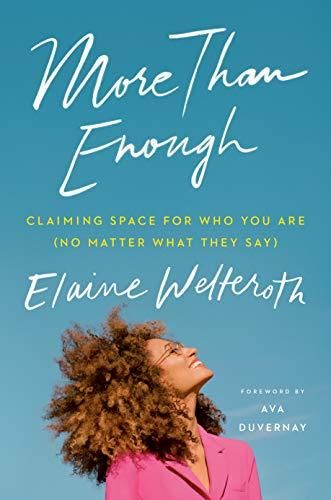Former Teen Vogue chief Elaine Welteroth describes her upbringing as a child of biracial parents and how her “otherness” affected her self-image, her sense of belonging and her remarkable career.

An Outlier’s Success
How does race figure into American society’s and media’s beauty metrics? Former editor-in-chief of Teen Vogue Elaine Welteroth brings wit and experience to bear on these and other penetrating questions in her stunning memoir. The biracial daughter of a Black mother and a Caucasian father, Welteroth addresses the racism inherent in the beauty standards that dominate mainstream media and the fashion press. She decribes the effects of these standards on her emotions and self-image with admirable candor. Her insights into how racism permeates all aspects of the media world will surprise, engage and inspire you, regardless of your background.
Many Firsts
Elaine Welteroth achieved many firsts. She was the youngest person and only the second Black American to lead a Condé Nast publication when she became editor of Teen Vogue.
When a girl is born, a universe of possibilities is born within her.Elaine Welteroth
During a preschool arts-and-crafts assignment, Welteroth’s teacher told the class to create a family collage by cutting out images from magazines. The photos offered few pictures of people with black, brown or tan skin. The lack of diversity verified a reality Welteroth already understood: She was an outlier in a white world.
Beauty and Self-Acceptance
Faced with Eurocentric beauty standards at school, Welteroth felt invisible, and her self-esteem shrank before she hit her teen years.
For so much of our lives we are told what beauty is, what it looks like, who possesses it, who doesn’t…And the ones pushed to the margins are rarely given the pen to write ourselves and our own definitions in. Elaine Welteroth
But Welteroth discovered that her mixed-race hair texture and skin tone enabled her to explore her racial identity. Depending on her hairstyle, Welteroth blended into communities of “Afro Latinos, East Africans, Indians and Polynesians.” She also encountered “light-skin privilege”: a status conferred on Black Americans with pale or light brown skin and straight or wavy hair.
Two Worlds
As a biracial child, Welteroth felt caught between two worlds and at home in neither one.At her Caucasian schools, she became the “token Black friend.” In the Black community, she often felt insufficiently Black.
To be mixed race in America is to exist in a constant state of in-between. You have access to two worlds and are expected to be fluent in both, yet you never belong fully to either one.Elaine Welteroth
But at a white party, a male student bumped into Welteroth and called her a double expletive. Welteroth realized that, despite her golden skin, curly hair and Caucasian father, the world regarded her as Black.
I Am Not My Hair
Welteroth found a life-changing mentor in her biracial college professor Dr. Michele Foss-Snowden, who assigned her class to write a paper about cultural messages. Welteroth selected the song, I Am Not My Hair, by Afrocentric artist India.Arie.
I began questioning and examining my own light-skin privilege as a biracial Black woman in America. I could see the ways in which I benefited from inherently racist hierarchy that favored Eurocentric beauty standards.Elaine Welteroth
Inspired by her academic examination of beauty standards and racism, Welteroth vowed to combat white supremacy.
Essence and Ebony
Welteroth told Foss that finding a position at Essence, the leading fashion and beauty magazine for Black women, was her dream job. Foss thought Welteroth would make an excellent magazine editor.
When women affirm women, it unlocks our power. It gives us permission to shine brighter.Elaine Welteroth
Her mentor’s endorsement showed Welteroth that affirmation from other women, relatives and teachers can “unlock” hidden powers, talents and goals.She landed summer internships at Essence and Ebony magazines.
Michelle Obama
Welteroth contributed to a photo shoot with Michelle Obama months before Barack Obama’s election as president. Ebony became the first magazine to run a cover photo and feature about the historic First Lady.
Welteroth later took a full-time job as an Ebony production assistant. The job enabled her to meet and network with superstars of the fashion industry.
Glamour
But Welteroth found working at Ebony stamped her resume with a “scarlet letter.” She interviewed for jobs at fashion magazines for a year before Holly Siegel, a beauty editor at Glamour, recruited her.
Pinched inside nearly every rejection notice was the term ‘overqualified.’ I couldn’t help but see through the coded language.Elaine Welteroth
Welteroth represented Glamour on morning TV talk shows, ran the beauty makeover section and worked on key photoshoots, yet she still encountered an unspoken wall of “otherness.” Her race, relative youth at 24 and blue-collar background differentiated her from most Condé Nast staffers.
Racial Milestones
Eva Chen, the director of beauty and health at Teen Vogue, planned to retire and offered her job to Welteroth, who thus became the “first Black beauty director in Condé Nast’s 107-year history.” She was dismayed that racial milestones remained newsworthy in 2012.
No matter how much you try to blend in, your race walks into every room before you do.Elaine Welteroth
At Teen Vogue, which featured Black models and actresses, Welteroth nurtured an inclusive, diverse beauty culture in terms of race, gender and sexual identity. Legendary Vogue editor Anna Wintour selected Welteroth to become editor-in-chief of Teen Vogue in early 2016.
Teen Vogue
Publicly, Condé Nast celebrated Welteroth’s promotion as progress. Privately, the move made Welteroth feel shortchanged and diminished; her new salary did not reflect her position nor did it match that of her industry peers. Condé Nast gave Welteroth a lofty title but undercut her by appointing a team of co-leaders.
To change the stories, you must change the storytellers.Elaine Welteroth
Welteroth ultimately negotiated a higher salary and consolidated her authority.She expanded the magazine’s reach on social media and television. Teen Vogue posted robust sales and advertising revenue.
But, shortly before Welteroth took the stage to introduce Hillary Clinton at the Teen Vogue Summit, Condé Nast announced it would no longer publish a print edition of the magazine. The company offered Welteroth positions and opportunities at Condé Nast, but she declined them all. Instead, she contacted a top Hollywood agent and began networking with her professional and creative connections to take her next step forward.
Finding Her Voice
Welteroth never complains and never portrays herself as a victim. She offers a clear-eyed assessment of racism in the United States and how it manifests in executive suites, throughout the media and in her own psyche. Welteroth, as you would expect from a Condé Nast editor, doesn’t hide her ambitions and writes with ferocious wit in punchy, memorable sentences. Her experience is unique, and she will inspire any young woman wrestling with ambition and self-image.
Other highlights among inspiring books by Black women leaders include What I Know For Sure by Oprah Winfrey; The Little Black Book of Success by Elaine Meryl Brown, Marsha Haygood and Rhonda Joy McLean; and Expect to Win by Carla Harris.










